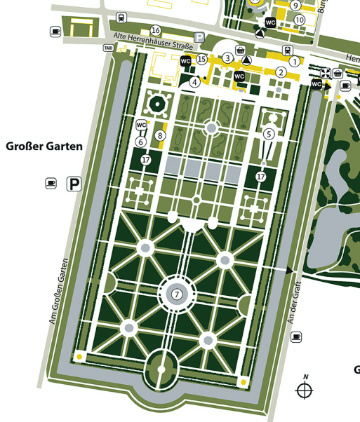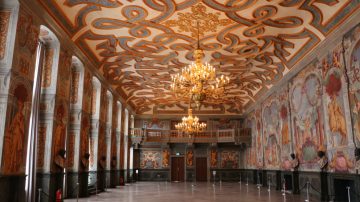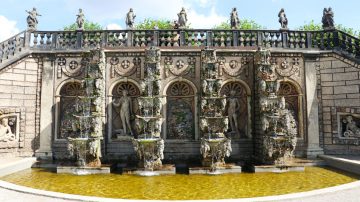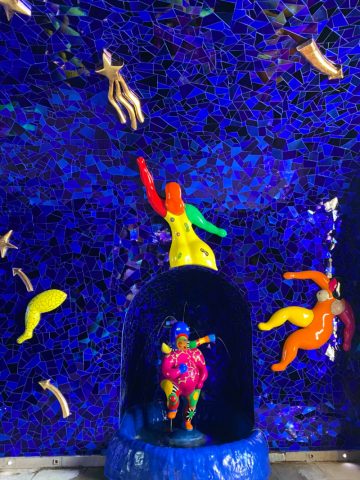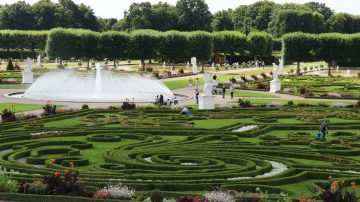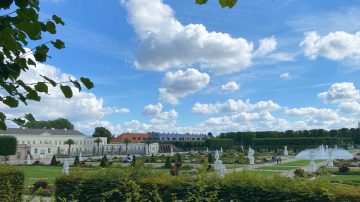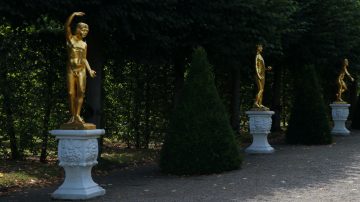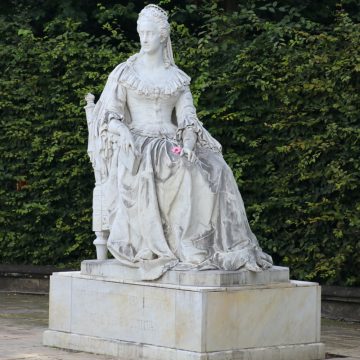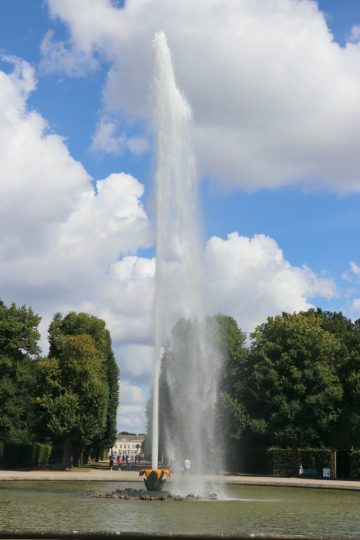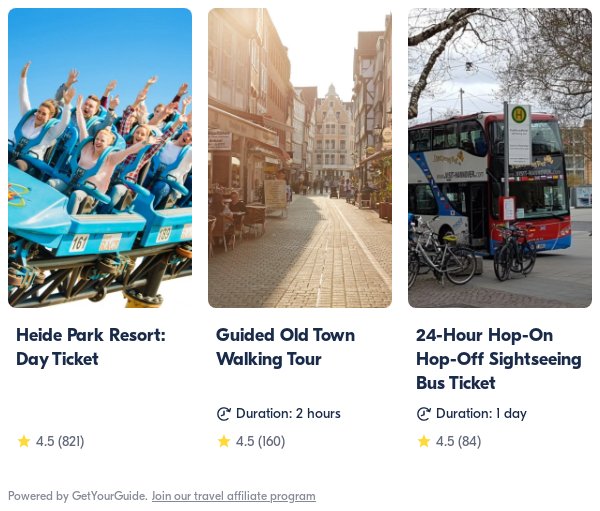The formal Grosser Garten (Great Garden) at Herrenhausen in Hannover is one of the most important and beautiful baroque parks in Germany and indeed Europe.

The Great Garden (Großer Garten) of Herrenhausen in Hannover in Lower Saxony in German is one of the largest and most important baroque gardens in Europe. Highlights of a visit include the parterres de broderie with sculptures and water features, the original baroque open-air theatre, the great fountain, and the grotto by Nikki de Saint Phalle. Try visiting while the fountains are playing.
Great Garden of Herrenhausen in Hanover
The formal baroque Grosser Garten (Great Garden) is the main garden of Schloss Herrenhausen, a former summer palace of the kings of Hannover in Lower Saxony (Niedersachsen) in Germany. Although neglected at times, it is one of very few large Baroque court gardens in Germany that was never altered to a cheaper-to-maintain landscape park. It is currently in a superbly maintained condition and one of the top sights to visit in Hanover.
The Großer Garten measures 50.2 hectare, or a rectangle of 905 by 555 m. Without the moat area, the measurements are 800 by 450 m, which are conveniently for imperial measurements half a mile by a quarter mile. It has 20 km of hornbeam hedges and 15 km of box bush hedges.
Although originally established in the late 17th century, the current formal gardens of the Herrenhausen Palace are largely a project of the 1930s and restoration following the Second World War. The gardens are in a magnificent condition and the best baroque gardens in Germany.
The garden was opened to the public already in the mid-18th century. In contrast to many others, visitors required no rank, status, or title. Maintaining basic manners while visiting was good enough.
See Visit the Baroque Herrenhausen Gardens in Hannover for more on the history of the gardens and the House of Hannover.
Quick Orientation of the Großer Garten
Carving a park into well-defined symmetrical sections is of course par for the course in a Baroque garden. However, for a quick orientation of the Großer Garten, it is sensible to divide it first into three main areas, which will require many further divisions later on:
- The Schloss and a few small gardens and structures (grotto and cascade) directly at the palace.
- The northern half of the garden with the grand parterre and carefully crafted boxed-in gardens.
- The southern half with the bigger divisions and the great fountain at its center.
Schloss Herrenhausen and the Galerie
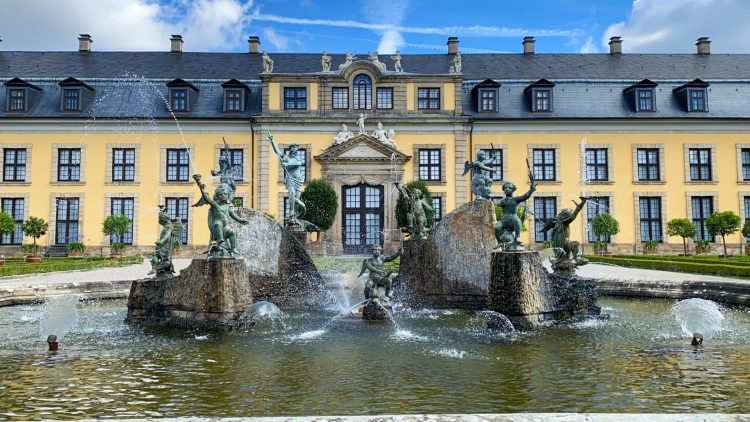
Schloss Herrenhausen was a summer residence where the Hanoverians always spent more on the gardens than on the palace. The original palace burnt down literally to ashes and an external staircase during the Second World War. The present building completed in 2013 looks like the neoclassical facade from the early 19th century but the interior is completely modern and used as a reception and event center.
The small museum inside the palace is interesting but modest — visit it only after the gardens if time is left over.
The current entrance to the Great Garden is from the east wing of the Schloss through a small flower garden that was originally reserved for the private use of the royal family only. The rebuilt palace and the Galeriegebäude (Gallery) are linked by a glass pavilion designed by Danish star architect Arne Jacobsen (1964). The parallel running iron arcade is almost the only 19th-century addition to the garden that survived.
The Galerie was originally used to preserve plants during the winter but that task was taken over by the Orangerie behind it. The Galerie was converted into a banqueting hall with the frescoes by Tommaso Giusti showing events from the Aeneas Saga. Busts of Roman Emperors show who the Hanoverians would prefer to be associated with.
In front of the Galeriegebäude is the Orangenparterre (Orange Parterre). In 1714, it contained no fewer than 400 orange trees. The current baroque layout is from the mid-1960s while the Neptune fountain by Magnus Kleine-Tebbe was only installed in 2008.
Grotto and Great Cascade of Herrenhausen
Before venturing into the formal garden, see the cascade and grotto and especially the views from the upper balconies. Both the Grotto (Grotte) and Great Cascade (Kaskade) were originally installed during the late 17th century. Then, as now, the viewing platforms could be reached by elevated walkways from the palace or via the stairs from the garden.
The structure of both the cascade and grotto survived from the 17th century. However, due to the humidity, maintenance work was constantly necessary and with time the decorations were increasingly less elaborated. The central figures of the cascade are Venus and Leda with further statues of mythical gods on the balcony.
Nikki de Saint Phalle Grotto
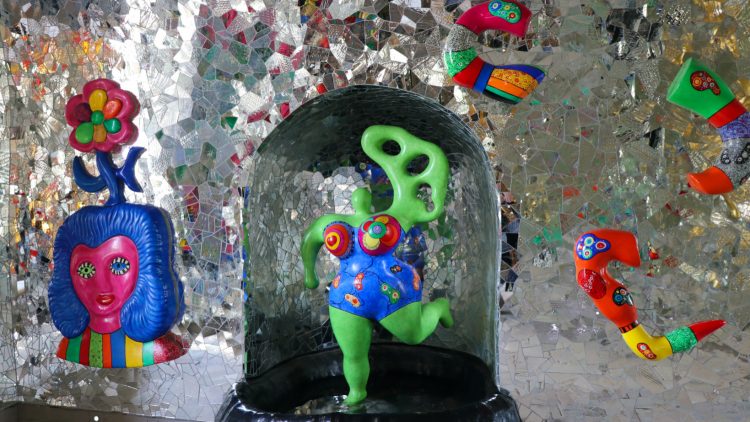
The grotto of Herrenhausen, after long being used for storage, regained its original purpose as a retreat from the heat in 2003. The colorful interior is instantly recognizable as the work of the French-Swiss artist Nikki de Saint Phalle (1930-2002).
The Grotto is considered the final large work of Nikki de Saint Phalle. It was completed after her death but to her exact designs. The central theme is “Human Life” with spirituality the theme of the central room that is lined with bands of colorful tiles.
The blue room symbolizes “Night and Cosmos” with stars and dancing females. The opposite “Day and Life” room is lined with mirrors and images of humans and a variety of animals. The decorative latticework of the windows is also with mirrors to her designs.
The fountain in the mirror room is known as the “Nana of Herrenhausen”. In 1974, three of Nikki de Saint Phalle’s famous Nanas were exhibited in public in Hannover. They were initially controversial but the resulting publicity ensured huge popularity for Nikki de Saint Phalle in Germany ever since. Shortly before her death, she donated 400 works to the Sprengel Museum Hannover and created the updated design for the Herrenhausen grotto.
Northern Section of the Baroque Great Garden of Herrenhausen
Seen from the Schloss — viewing platform above the great cascade and grotto — the northern half of the formal garden may be divided into:
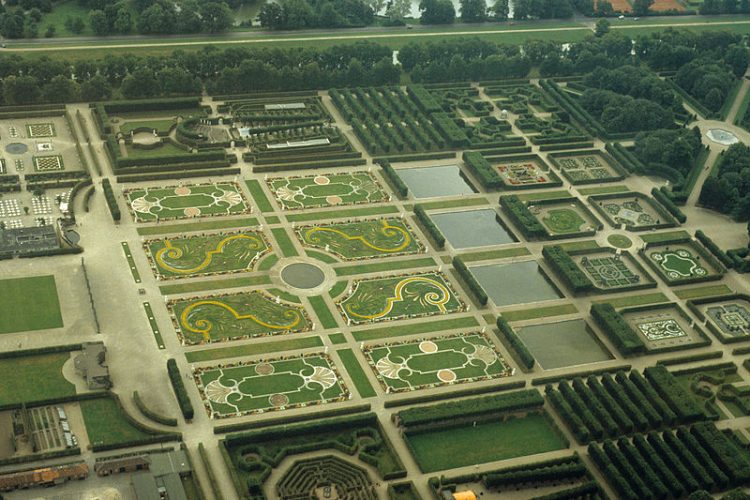
Großes Parterre / Great Parterre
The central part of the garden directly in front of the Schloss measures 200 m wide and 160 m deep. This is the typical Baroque court parterres de broderie garden divided into eight rectangles.
At the center is a bell fountain (Glockenfontäne) with 164 individual spouts.
The decorative flower beds are enhanced by 32 sandstone sculptures that are painted white to remind of marble. These sculptures and ornamental vases are allegories of the seasons, elements, the four known continents, and mythical figures.
Schwanenteiche — the four swan lakes behind the great parterre were originally fish ponds but later also used for farming ducks and swans. In the 18th century, this area was visually screened off from the main parterre but following the restoration of the 1930s became a visually integral part of the great parterre.
Maze and Elevated Viewing Platform
The parterre and lakes are visually enclosed by a bosquette of mostly hornbeam trees (Hainbuchen). Viewed from the Schloss, starting from the right, the gardens in a U-shape outside this tree hedge are mostly designs from the 1930s and include:
The maze “Irrgarten” is based on plans from the 17th century but drawings of the gardens from previous centuries do not show such an attraction. The elevated viewing platform (picnicking allowed) and a rehearsal stage (Probehühne) with the only WC in the garden other than at the Schloss are similarly only 20th-century additions.
Behind this area, on both sides of the swan ponds, are the Lindenstücke with rows of linden (lime) trees. In these areas, as well as along the moat, picnicking is also allowed.
Eight Special Gardens (Sondergärten)
Behind the swan ponds are eight special small thematic gardens boxed in by hedges. These show gardens follow design ideas from the 17th and 18th centuries but were added only in the 1930s.
The eight special thematic gardens are:
- Lower German rose garden
- Lawn garden
- Island garden
- Renaissance garden
- Baroque garden
- Lower German flower garden
- Fountain garden

Gartentheater (Garden Theatre)
To the left of the great parterre is the Gartentheater (Garden Theatre), which was first used in 1692 and one of very few baroque open-air theaters to have survived to the present. It is still frequently used — see visitors’ information and events for more details.
The theater is still lined by 18 of the original 27 sculptures based on works from antiquity including Venus Medici and the musicians following Dionysos. These were made of lead around 1690 and painted golden.
Southern Half of the Großer Garten in Herrenhausen
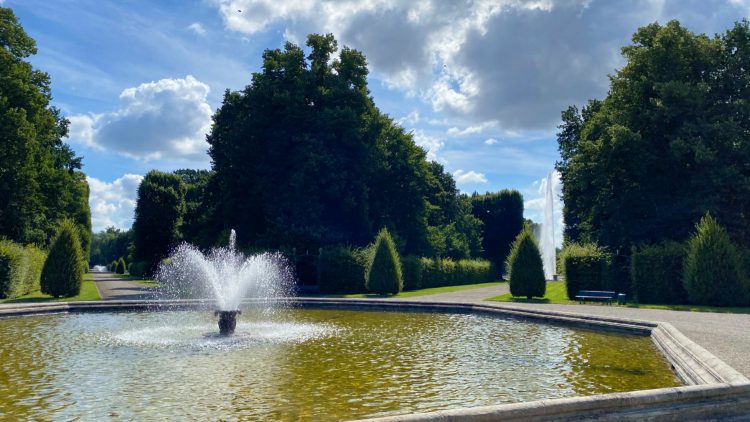
The bosquette garden in the southern half of the Großer Garten largely follows the original geometric plan from 1696. The large square area is divided into four smaller squares — separated by broad allees. The squares are each divided into eight triangles — separated by paths with a fountain at the central meeting points.
The Große Fontäne (Great Fountain) is at the center of the southern garden where the two main allees and smaller paths cross.
During the 18th century, this area was planted with fruit trees, allowing the court to enjoy both the blossoms and the fruit. However, during the restorations of the 1930s, all fruit trees were removed to bring the garden more in line with the French baroque garden theory of a complete separation between pleasure and market garden
Two monuments are at the division of the northern and southern halves of the Great Garden:
- A fairly unimpressive part of a staircase from the original palace was moved here when the Schloss was rebuilt. This is the only part of the original palace that survived the air raid and subsequent fires during the Second World War.
- The marble statue of a seated Electress Sophie (1630-1714) who died on this spot from a heart attack while taking her daily stroll in her beloved garden. If she lived two months longer, she would have been queen of England in her own right (in Germany a woman could only be consort) rather than her son becoming King George I of Great Britain.
Große Fontäne (Great Fountain) of Herrenhausen
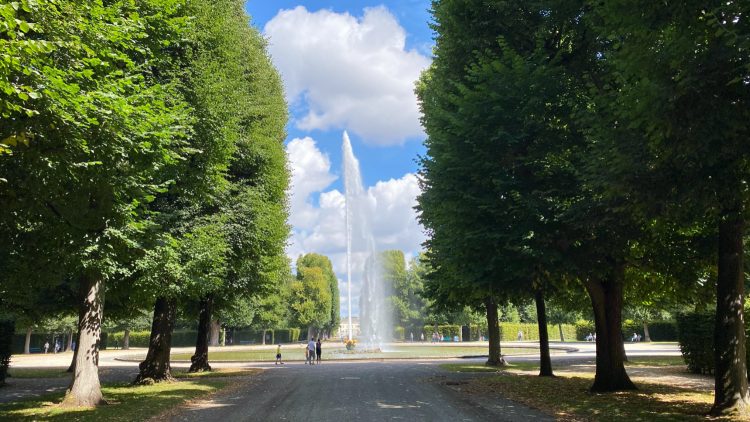
The Great Fountain of Herrenhausen has an interesting history of its own. Around 1700, elector Georg Ludwig — the later George I of Great Britain — started a prestige project with the aim to have his fountain spew higher than the 27 m achieved in the Bassin du Dragon in Versailles.
The flat geography of Herrenhausen offered no help so only superior technology could achieve this goal. After huge expense in both technology and manpower, a new system of amongst others five water wheels and 40 pressure pumps built by German and British specialists was tested in the presence of the king in 1719 to reach only 5 m instead of the hoped for 20 m.
A further round of improvements followed and in September 1720 George I had the highest water jet of any court in Europe when the Great Fountain spewed 35 m high. The total cost of this prestige project was 220,000 Reichstaler — Dresden got the Frauenkirche built for only 10,000 more.
In the mid-19th century, the Hanoverians felt it necessary to improve technology to reclaim the record. Better pipes increased the height to 44 m. However, a new pump installation was required to go to 67 m in 1863, as the second highest park fountain in Europe. This pump is still in working condition but used to regulate the water level of the moat.
The present electrically driven pump of the Great Fountain was installed in 1956. It forces water through a 4 mm circular slit making the jet hollow to reach up to 81 m (usually only 72 m) while using only 500,000 liter of water per hour. The Jet d’Eau in Geneva reaches 140 m but requires 500 liter of water per second.
Moat Surrounding the Großer Garten
Der Große Garten is surrounded on three sides by the Graft — a Low German word from the Dutch “gracht” meaning canal or moat. It dates from 1700 and was a more elegant solution than a fence or wall at a time when the park was still surrounded by countryside and Hannover only a city in the far distance.
On the garden side, the moat is lined by a triple row of Linden trees — walking the full U is around 2 km. The outside of the moat is freely accessible.
In the two far corners of the garden are two early 18th-century pavilions by Louis Remy de la Fosse.
Other Large Baroque Gardens in Germany
Some other large baroque gardens in Germany include:
- Ludwigsburg Palace near Stuttgart
- Schloss Schleißheim in the north of Munich
- Schloss Nymphenburg in the west of Munich
- Würzburg Residence
- Augustusburg and Falkenlust Palaces in Brühl near Cologne
Visit Herrenhausen and Hannover
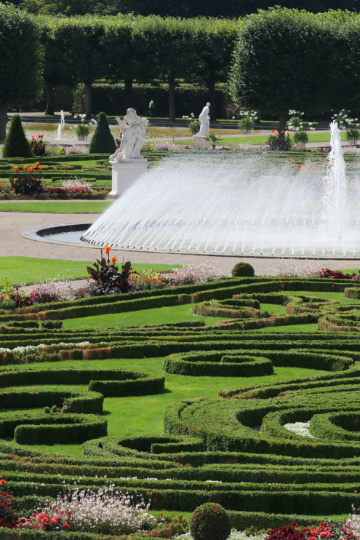
- See Visit the Herrenhausen Gardens for more on the House of Hanover and the other parts of the Herrenhäuser Gärten
- Visit the Großer Garten at Herrenhausen for more on the magnificent formal Baroque Great Garden.
- Visitors Information for the Herrenhausen Gardens for opening hours, ticket prices, events, and transportation.
- More photos of the Herrenhäuser Gärten on Flickr.
- Herrenhausen official website at Hannover Tourismus.
- Hannover is an important trade show venue. At quiet times, the excess of hotel rooms often means very cheap prices, especially if willing to stay in the then lifeless area near the Messe. See Tripadvisor or good deals and ratings on Hannover hotels.
- Public Transportation — German Railways timetables to stop Herrenhäuser Gärten
